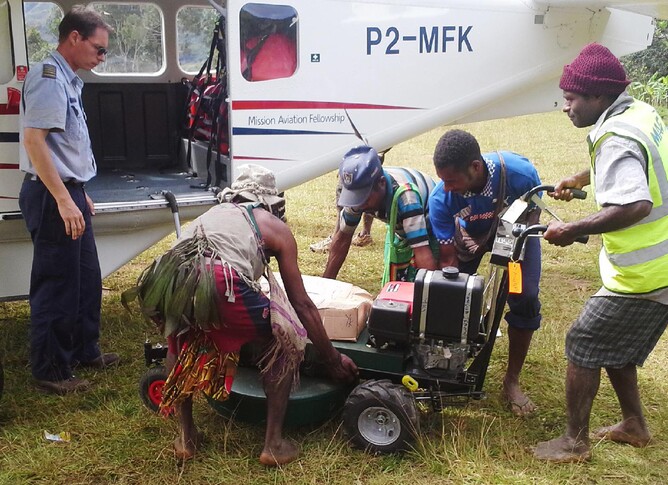Well-maintained airstrips are essential for MAF operations into remote communities. MAF flights are often the only way in and out of basic services, especially in the case of a medical emergency. In PNG the Rural Airstrip Agency (RAA) and MAF partner together to support villages in keeping their lifeline safe and accessible for our aircraft.
However, it is the community itself who is responsible for looking after their airstrip.
“I’ve been to five airstrips in Enga yesterday, and now I am going to Jiwaka airstrips. I’ve been to two already and now my pilot will take me to another three“, says Joseph, an elderly men with a big smile shining through his big grey beard. This makes a total of 10 landings at different airstrips in two days. He admits that “sometimes it is scary. The clouds, you know, we can’t see the trees when we fly over the white clouds. I know the pilots can make it down there. They know how to do it.“
On board those flights with Joseph were 1003 kg of fuel in total, which come under the International Dangerous Goods (DG) Regulations. On each round, the plane normally stops at two to three airstrip and delivers five jerry cans (100 litres) in each of those villages. For Joseph, having up to 300 kg of extra fuel in the cabin of the aircraft is a little bit scary.
I met Joseph and Janet Rowaro at the Mt Hagen MAF Base. Janet works for ATprojects and is in charge of the RAA program. With two more colleagues and under the supervising eyes of MAF Senior Cargo Officer John Yark, and Senior Traffic Officer Lewis Phalanger, they just finished refilling 10 bright red jerry cans each with 20 litres of fuel in order to go on the last round of one of their quarterly iRAMP fuel and maintenance trips (iRAMP: innovative Rural Airstrip Maintenance Program).
“Today I went to Ambuluwa and Kol, and now I go to Tsendiap, Koinambe and Junkaral“, explained Joseph to me. The day before he went to Iropena, Yenkisa, Maramuni, Eleme and Lapalama. “I go there to see the situation of the airstrip, the drainage, the lawn, the runway. I check the lawn mowers for maintenance if they need parts or oil or grease and all this. If the machine is not working there I take it back, like yesterday when I brought one from Eleme, and take it back to Goroka. There I do a maintenance audit and then we bring it back and deliver it to the airstrips“.
“At Eleme, the grass on the strip was already knee high and they didn’t cut it,“ confirmed Remi van Wermeskerken, Joseph’s pilot for those two days, reflecting on some of his encounters during those iRAMP charter flights. The lawn mower was broken and a rock or log sheared something inside the engine. At several other airstrips Joseph had to give out parts like the pull starter ropes, spark plugs or files to sharpen the blades. He brings a spare part kit with him so the communities get the parts they need to continue the work.
ATprojects looks after 11 airstrips in the Enga and Jiwaka Provinces and 13 in Western Province. It can be fairly difficult to persuade a community to really take ownership of their airstrip, faithfully maintaining it and realising that not only the two appointed RAA Airstrip Maintenance Volunteers (AMV) are the ones responsible. Janet confirms that “it is quite a challenge to try and convince the community to help the AMVs on the ground. Most of the time we really have to push them and tell them it is their airstrip and they have to maintain it regularly and not wait for us to come and issue them lawn mowers, because delivering and chartering flights on different schedules is very expensive. We always tell them to look for other options like using bush knifes to maintain the airstrip when they wait for us to bring the lawn mower part to them“.
